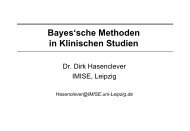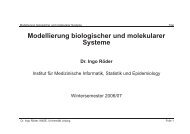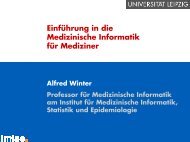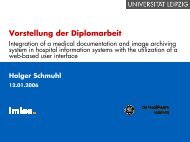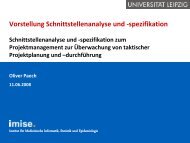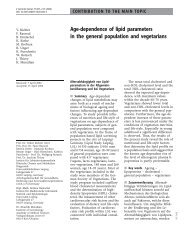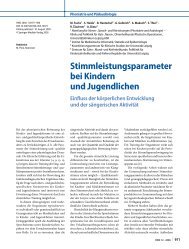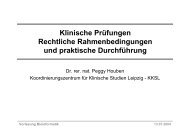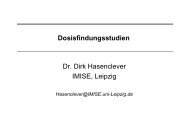Download (200 kB, 12 pages)
Download (200 kB, 12 pages)
Download (200 kB, 12 pages)
You also want an ePaper? Increase the reach of your titles
YUMPU automatically turns print PDFs into web optimized ePapers that Google loves.
Biometrical Journal 46 (<strong>200</strong>4) 6, 687–698<br />
DOI: 10.1002/bimj.<strong>200</strong>410067<br />
Micro Array Based Gene Expression Analysis<br />
using Parametric Multivariate Tests per Gene –<br />
A Generalized Application of Multiple Procedures<br />
with Data-driven Order of Hypotheses<br />
Ernst Schuster * ; 1 , Siegfried Kropf 2 , and Ingo Roeder ** ; 1; 3<br />
1 Institute for Medical Informatics, Statistics and Epidemiology, University of Leipzig, Leipzig, Germany<br />
2 Institute of Biometry and Medical Informatics, Otto von Guericke University Magdeburg, Magdeburg,<br />
Germany<br />
3 Interdisciplinary Centre for Bioinformatics, University of Leipzig, Leipzig, Germany<br />
Received 28 May <strong>200</strong>4, revised 24 August <strong>200</strong>4, accepted 27 August <strong>200</strong>4<br />
Summary<br />
Micro array technology allows the simultaneous analysis of ten-thousands of genes. Most often, however,<br />
the analysis is based on a few replications only. This causes problems in the application of classical<br />
multivariate tests which require sample sizes exceeding the number of observed variables. To overcome<br />
these problems, a class of stable, multivariate procedures based on the theory of spherical<br />
distributions has been proposed by Låuter, Glimm, and Kropf (1996). These methods allow the use of<br />
multivariate information of many genes for testing differential gene expression. Furthermore, multiple<br />
testing procedures based on these principles have been constructed (e.g., Kropf, Låuter, <strong>200</strong>2), which<br />
strictly keep the familywise type I error rate (FWE).<br />
In this paper, these methods have been generalized to allow for the use of full multivariate information<br />
on expression intensities of individual genes analysed by the Affymetrix GeneChip technology. In<br />
contrast to the usual strategy, which constructs an expression score for each gene, based on averaging<br />
of the different oligonucleotide (perfect- and miss-match) information, and then performs some test on<br />
these summarized expression values, we suggest using a test procedure based on the complete multivariate<br />
perfect match information. We show that a multiple FWE-controlling procedure for normally<br />
distributed data proposed by Westfall, Kropf, and Finos (<strong>200</strong>4), can be generalised to a more powerful<br />
procedure based on left-spherically distributed scores derived from the perfect match information, without<br />
losing the FWE-controlling property.<br />
To illustrate the proposed test procedures, which have been implemented in the statistical programming<br />
environment R, we analyse two already published data sets, comparing gene expression of tumour<br />
and healthy tissues within identical patients and between two groups of different patients, respectively.<br />
Using these examples, we demonstrated that the incorporation of the multivariate perfect match information<br />
is superior to classical expression score based methods with respect to the number of identifiable<br />
differentially expressed genes.<br />
Key words: Gene expression; Multiple tests; Score-based tests; Data-driven ordered hypotheses.<br />
1 Introduction<br />
Micro array technology allows the simultaneous analysis of tens of thousands of genes. In the simplest<br />
case, a paired sample of gene expression values, e.g. tumour versus normal tissue of the same<br />
* Corresponding author: e-mail: Ernst.Schuster@imise.uni-leipzig.de<br />
** This work has been supported by the Deutsche Forschungsgemeinschaft (DFG): grant BIZ 6/1-2.<br />
# <strong>200</strong>4 WILEY-VCH Verlag GmbH & Co. KGaA, Weinheim
688 E. Schuster, S. Kropf, and I. Roeder: Multiple Procedures for Micro Array Based Gene Expression<br />
individual, is analysed for differential expression. Most often, however, the number of samples n (i.e.<br />
hybridised micro arrays) is restricted to a few replicates, which causes problems in the application of<br />
classical multivariate test procedures. These procedures require sample sizes exceeding the number p<br />
of observed variables (i.e. genes). Facing this problem, the presented work will focus on the application<br />
and extension of methods developed by Låuter, Glimm, and Kropf (1998) specifically for this<br />
non-classical situation.<br />
Testing of all individual genes accessible by the experimental procedure at a significance level a<br />
appropriate for a single test (e.g. a ¼ 0.05) would lead to an extremely high number of false positive<br />
test results. Therefore, throughout this manuscript, a familywise type I error (FWE) in the strong<br />
sense will be considered. Keeping the FWE in the strong sense means, that irrespective of the number<br />
of true null-hypothesis, the probability of ending up with at least one false positive test decision is<br />
restricted to a given significance level.<br />
Let us first consider the so called one-sample situation. Here, one has n independent, identically<br />
distributed (iid) p-dimensional sample vectors (which might also be differences from corresponding<br />
sample elements of two dependent samples):<br />
0 1<br />
x j ¼<br />
B<br />
@<br />
x j1<br />
.<br />
.<br />
x jp<br />
C<br />
A N p ðm; SÞ ;<br />
0<br />
m 1<br />
B .<br />
with expectation m ¼ @<br />
m p<br />
1<br />
j ¼ 1; ...; n<br />
C<br />
A and covariance matrix S ¼<br />
0<br />
s 11 <br />
1<br />
s 1p<br />
B<br />
@<br />
. . . . . C<br />
A.<br />
s p1 s pp<br />
The data matrix subsuming all p-dimensional sample vectors x 0 j (j ¼ 1; ...; n) is denoted by<br />
0<br />
1<br />
x 11 x 1p<br />
B<br />
X ¼ @<br />
.<br />
.<br />
.<br />
. .<br />
.<br />
.<br />
C<br />
A :<br />
x n1 x np<br />
The multiple test procedures for the local hypotheses H i : m i ¼ 0 ði ¼ 1; ...; pÞ treated in the sequel,<br />
are based on a class of global multivariate tests given in Låuter, Glimm, and Kropf (1996). This<br />
article also provides the proof of the following theorem.<br />
Theorem 1 Consider the random matrix X as above under the global null hypothesis H : m ¼ 0.<br />
Let d be a p-dimensional weight vector and D a p q weight matrix (q min (p, n 1)), which<br />
depend on X only through the sums of products matrix W ¼ X 0 X (with the additional restriction that<br />
rank (Xd) = 1 or rank (XD) =q, both with probability 1). Then for<br />
0 1<br />
0 1<br />
z ¼<br />
B<br />
@<br />
z 1<br />
. .<br />
.<br />
C<br />
B<br />
A ¼ Xd and Z ¼ @<br />
z 1<br />
. .<br />
.<br />
C<br />
A ¼ XD<br />
z n<br />
the following statements hold:<br />
z n<br />
1. The score vector z and the score matrix Z are both pffiffiffi<br />
left-spherically distributed.<br />
n z<br />
2. The classical t-test for the univariate scores t ¼ with z ¼ 1 s z n z0 1 n (1 n is a vector consisting of<br />
n ones) and s 2 z ¼ 1<br />
n 1 ðz0 z nz 2 Þ provides an exactly t-distributed statistic with n 1 degrees<br />
of freedom.<br />
3. Analogously, with T 2 ¼ nz 0 Sz 1 z, where z ¼ 1 n Z0 1 n and S z ¼ 1<br />
n 1 ðZ0 Z nzz 0 Þ, the statistic<br />
F ¼ n q<br />
ðn 1Þq T2 has an exact F-distribution with q and n – q degrees of freedom.<br />
# <strong>200</strong>4 WILEY-VCH Verlag GmbH & Co. KGaA, Weinheim
Biometrical Journal 46 (<strong>200</strong>4) 6 689<br />
Applying these results, Kropf and Låuter (<strong>200</strong>2) have proposed the following multiple procedure for<br />
testing the univariate local hypotheses H i , which strictly keeps the familywise type I error level a:<br />
Procedure I:<br />
1. Sort the variables for decreasing values of w i ¼ Pn<br />
j¼1<br />
x 2 jiði ¼ 1; ...; pÞ.<br />
2. Carry out, in this order, the usual one-sample t-tests for the variables at the unadjusted error<br />
level a as long as significance occurs. Stop at the first non-significant test.<br />
The proof that this procedure keeps the FWE in the strong sense, despite the data-driven ordering of<br />
variables, uses Theorem 1 with specific weight vectors. These have weight 1 for the variable with<br />
maximum value of w i and 0 otherwise. This induces a degeneration of the multivariate test to an<br />
univariate one using the gene which occupies the key position in Procedure 1. Please note that the w i<br />
are the diagonal elements of the matrix W. For more details of the proof we refer to the above cited<br />
paper. The basic idea underlying the ordering in Procedure I is the decomposition<br />
P n<br />
j¼1<br />
x 2 ji ¼ n x2 i þ Pn<br />
j¼1<br />
ðx ji x i Þ 2 ¼ s 2 i ðt2 i þ n 1Þ ;<br />
where x i and s i denote the usual variablewise mean and standard deviation, and t i ¼ x i pffiffi<br />
n the corresponding<br />
univariate test statistic. Assuming the variances to be approximately equal, variables with<br />
s i<br />
higher absolute means and, therefore, more extreme t-values, will have increased chances to be in the<br />
first positions after sorting and to be detected as significant in the test procedure.<br />
The assumption of approximately equal variances in the p variables may appear very restrictive,<br />
however, as discussed by Schuster and Kropf (<strong>200</strong>2) it is rather natural, e.g. in the context of repeated<br />
measurements. Furthermore, such an assumption is often achievable by a suitable non-linear transformations<br />
of the data. In the context of gene-expression data (see example below), a logarithmic transformation<br />
may yield approximately normal variables with roughly equal variances.<br />
If variables with increased variances and no effects in the expectations occur, they may cause an<br />
early stopping of the procedure. To reduce this risk, Westfall, Kropf, and Finos (<strong>200</strong>4) proposed using<br />
the same sums of squares w i (as in the above procedure) to weight the raw P-values in a weighted<br />
Bonferroni-Holm procedure (Holm, 1979), which strictly keeps the familywise type I error level a:<br />
Procedure II:<br />
1. Calculate the P-values P i ði ¼ 1; ...; pÞ for the usual unadjusted t-tests for each of the p variables.<br />
2. For each variable, determine the sums of squares values w i as above and the weights g i ¼ w h i for<br />
a fixed value h 0.<br />
3. Calculate the weighted P-values Q i ¼ P i =g i and sort the variables for increasing values:<br />
Q i1 Q i2 Q ip or Q ð1Þ Q ð2Þ Q ðpÞ , respectively. Define the index sets<br />
S j ¼fi j ; i jþ1 ; ...; i p gðj ¼ 1; ...; pÞ.<br />
4. The ordered hypotheses H ðjÞ (j ¼ 1; 2; ...) are rejected as long as Q ðjÞ P<br />
a .<br />
Stop at the first j yielding a higher value Q<br />
g h ðjÞ .<br />
h2S j<br />
If h equals zero, this weighted Bonferroni-Holm procedure (Procedure II) coincides with the classical<br />
Bonferroni-Holm method. Furthermore, as shown previously in Westfall and Krishen (<strong>200</strong>1) for<br />
the case of fixed weights, Procedure II converges to Procedure I if h tends to infinity. Therefore, the<br />
choice of a large h is appropriate if the variances are expected to be homogenous to a high degree. In<br />
contrast, small values of h are preferable for a considerable expected level of heterogeneity of the p<br />
variances. (see also Discussion).<br />
To compare two independent samples x ðmÞ<br />
j N p ðm ðmÞ ; SÞ (j ¼ 1; ...; n m ; m ¼ 1; 2) (two-sample situation)<br />
with expectations m ðmÞ ¼ðm ðmÞ<br />
1<br />
; ...; m ðmÞ<br />
p Þ 0 and common covariance matrix S, the local null<br />
# <strong>200</strong>4 WILEY-VCH Verlag GmbH & Co. KGaA, Weinheim
690 E. Schuster, S. Kropf, and I. Roeder: Multiple Procedures for Micro Array Based Gene Expression<br />
hypotheses H i : m ð1Þ<br />
i ¼ m ð2Þ<br />
i<br />
diagonal elements w i ¼ P2<br />
(i ¼ 1, ..., p) are tested in the corresponding two-sample t-tests and the<br />
P n m<br />
m¼1 j¼1<br />
ðx ðmÞ<br />
ji x i Þ 2 (x i is the total mean of the i-th variable over all<br />
n ¼ n 1 þ n 2 sample elements) of the sums of products matrix W ¼ðX XÞ 0 ðX XÞ with X ¼ 1 n x 0<br />
and x ¼ 1 n 10 n X ðn ¼ n 1 þ n 2 Þ are used. The remaining parts of Procedures I and II are identical to<br />
the one-sample case.<br />
To determine the expression level of individual genes, the Affymetrix-type GeneChip 1 technology<br />
uses several different (about 16–20) oligo-nucleotide (oligo) measurements. For each oligo, two different<br />
sequences (which differ in one base only), the so called perfect-match (PM) and the miss-match<br />
(MM), are determined (Affymetrix, <strong>200</strong>2). To estimate the corresponding expression level of the<br />
genes, one usually contrasts these two types of matches and thus summarizes in some sense over the<br />
oligos belonging to a given gene. Herein, all genes are treated according to one common rule. Subseqently,<br />
the obtained expression values are used to ascertain differentially expressed genes.<br />
In contrast to this approach, we propose here a test procedure which incorporates the total information<br />
of all individual PMs into the test for differential gene expression, using individual, gene specific<br />
rules for the construction of a multivariate expression score. Therefore, Procedures I and II are transferred<br />
into another multivariate context. Keeping the control over the FWE, we will use scores from<br />
multivariate tests (e.g. principle component test or standardised sum test) proposed by Låuter et al.<br />
(1996) as input for the above introduced multiple procedures. Summarizing the above statements, one<br />
can say that the essential novelty of our approach is the use of data dependent, gene specific weights<br />
rather than one common, gene independent rule in the construction of expression scores.<br />
In the following section the derivation of the amended multiple procedures is described in detail.<br />
Moreover, we provide the proof for its strong control of the claimed FWE criteria. Two examples using<br />
published data are presented in Section 3, followed by a discussion in the last section. A technical<br />
description of two R-routines for the application of the proposed procedures is outlined in the appendix.<br />
2 Multiple Test Procedures with Parametric Multivariate Tests per Gene<br />
Our approach is based on Affymetrix raw data values including the information of all oligos per gene<br />
(i.e. cel-file level). It is assumed that the PMs follow a common multivariate normal distribution. Let<br />
k be the number of genes and p i the oligos number of gene i. From this, it follows that the total<br />
number of PMs is given by p ¼ Pk<br />
p i .<br />
i¼1<br />
Firstly, we consider the one-sample situation, where the data usually represent difference values from<br />
two conditions in the same individual. The column vector containing all p i PMs of individual j and gene i<br />
is denoted by x ji (j =1,..., n; i =1,..., k). Thus, the whole vector for individual j is composed as<br />
0 1<br />
x j ¼<br />
B<br />
@<br />
x j1<br />
.<br />
.<br />
x jk<br />
with expectation m ¼<br />
C<br />
A N p ðm; SÞ<br />
0<br />
B<br />
@<br />
m 1<br />
.<br />
.<br />
m k<br />
1<br />
ðj ¼ 1; ...; nÞ<br />
C<br />
A and covariance matrix S ¼<br />
0<br />
1<br />
S 11 S 1k<br />
B<br />
. .<br />
.<br />
. .<br />
. C<br />
@<br />
A.<br />
S k1 S kk<br />
Again, the n sample vectors are summarized to the n p data matrix X ¼ðX 1 X k Þ with the<br />
transposed vectors x j as rows, and the total sums of products matrix W is given by<br />
0<br />
1<br />
W 11 W 1k<br />
B . .<br />
W ¼<br />
. . . C<br />
@<br />
A ¼ðX 1 X k Þ 0 ðX 1 X k Þ¼X 0 X :<br />
W k1 W kk<br />
# <strong>200</strong>4 WILEY-VCH Verlag GmbH & Co. KGaA, Weinheim
Biometrical Journal 46 (<strong>200</strong>4) 6 691<br />
Now, the local hypotheses H i : m i ¼ 0 (i = 1,..., k) are multivariate and are treated according to<br />
Theorem 1. The scores derived in these tests are then used in Procedures I and II in the same manner<br />
as the single variables previously.<br />
Here, we will consider four different choices for the weight vectors from Theorem 1 (for details see<br />
Låuter et al., 1996 or Kropf, <strong>200</strong>0). The weight vector for gene i (denoted by c i , i ¼ 1; ...; k) is<br />
obtained for<br />
1. the non standardized principle component (NPC) test as the eigenvector c i corresponding to the<br />
largest eigenvalue of the eigenvalue problem W ii c i ¼ lc i with c 0 i c i ¼ 1;<br />
2. the standardized principle component (SPC) test as the eigenvector c i of the largest eigenvalue of<br />
the eigenvalue problems W ii c i ¼ Diag ðW ii Þ c i with c 0 i Diag ðW iiÞ c i ¼ 1;<br />
3. the covariance sum (CS) test as c i ¼½Diag ðW ii ÞŠ<br />
1 W ii ½Diag ðW ii ÞŠ<br />
1=2 1 pi ;<br />
4. the standardised sum (SS) test as c i ¼½Diag ðW ii ÞŠ<br />
1=2 1 pi :<br />
To ensure that genes with balanced increased and decreased oligo measurements are not counted as<br />
differentially expressed, the weights c i are transformed to the modified form d i by:<br />
d i ¼ðd li Þ l¼1; ...; pi<br />
with d li ¼ jc lij<br />
P p ; l ¼ 1; ...; p<br />
i<br />
i ; i ¼ 1; ...; k :<br />
jc si j<br />
s¼1<br />
Using the transformed weights, the p i -dimensional data subvectors x ji are subsumed into a score by<br />
z ji ¼ d 0 i x ji. The one-sample t-test with the score values z ji (j ¼ 1, ..., n) now yields the unadjusted<br />
P-value P i for gene i (i ¼ 1, ..., k). Using the following theorem one can formulate generalized<br />
versions of the multiple test Procedures I and II.<br />
Theorem 2 Procedures I and II strictly meet a given FWE criteria if applied to left-spherically<br />
distributed scores z ij .<br />
To indicate the different assumptions (mulivariate normal and left-spherical), Procedures I and II<br />
will be denoted as Procedure I 0 and II 0 , respectively, if applied to left-spherically distrubuted scores.<br />
The subsequent proofs are extensions of the proofs given for Procedures I and II in Kropf and<br />
Låuter (<strong>200</strong>2) and Westfall et al. (<strong>200</strong>4), respectively.<br />
Proof of Theorem 2, Procedure I 0 Let M 0 ¼fi j m i ¼ 0; i 2f1; ...; kgg ¼ fi 1 ; ...; i k0 g of size k 0<br />
be the index set of the true local null hypotheses, i.e., of all those genes with expectation zero in all<br />
oligos, and let X 0 and W 0 be the corresponding submatrices of X and W, respectively. The case of<br />
empty M 0 can be neglected because no type I errors can occur then. All corresponding weight vectors<br />
d i1 ; ...; d ik0 are summarized into the weight matrix<br />
0<br />
1<br />
D 0 ¼<br />
B<br />
@<br />
d i1 0<br />
.<br />
.<br />
.<br />
. .<br />
.<br />
.<br />
0 d ik0<br />
C<br />
A :<br />
As the matrix X 0 consists of iid multivariate normal row vectors with expectation zero, and all four<br />
weight versions (incl. transformation from c i to d i ) use the data only through the corresponding sums<br />
of products matrix W 0 , we are in the framework of Theorem 1. Therefore, the whole matrix<br />
Z 0 ¼ X 0 D 0 is left-spherical as well as each of its columns which correspond to the scores in Procedures<br />
I 0 and II 0 . Thus, as shown in Låuter et al. (1998), Theorem 1 can be applied to the scores in the<br />
same way as to the raw data before.<br />
Let i 0 denote the index of the score with maximum w i from all scores from M 0 (uniquely determined<br />
with probability 1). Then a test according to Theorem 1 with the scores from M 0 and with the<br />
weight vector<br />
(<br />
d ¼ðd i Þ i¼1;...; k0<br />
; where d i ¼ 1 for w i ¼ max w l<br />
l¼1;...; k 0<br />
0 else<br />
# <strong>200</strong>4 WILEY-VCH Verlag GmbH & Co. KGaA, Weinheim
692 E. Schuster, S. Kropf, and I. Roeder: Multiple Procedures for Micro Array Based Gene Expression<br />
exactly keeps the type I error. That means that the local null hypothesis for the first score after sorting<br />
would be accepted with probability 1 a and the procedure would stop before any type I error occurs, if<br />
we would confine the procedure to those scores from M 0 . Actually, M 0 is unknown, and the sorting<br />
includes all scores. Therefore, the order obtained within M 0 is filled up with additional scores. This does<br />
not influence the tests with the scores within M 0 , but the tests for the additional scores (which cannot<br />
produce type I errors per definition) make the procedure more conservative if k 0 < k.<br />
Proof of Theorem 2, Procedure II 0 With the same notations as above, we consider the conditional<br />
distribution of Z 0 for fixed Z 0 0 Z 0. According to the theory of spherical distributions, this conditional<br />
distribution is again left-spherical. Therefore, the tests with the scores from M 0 (columns of Z 0 ) are<br />
again exact level a tests. If we additionally notice that the sums of squares w i used in Procedure II 0 as<br />
well as the weights g i are fixed for all i 2 M 0 in this conditional situation, then we can state that<br />
0<br />
P<br />
P i<br />
<br />
a<br />
1<br />
@ P<br />
g i g<br />
A ¼ P P i ag !<br />
i<br />
P ¼<br />
ag i<br />
P for all i 2 M 0 :<br />
m<br />
g m g m<br />
m2M 0 m2M 0 m2M 0<br />
Finally with g m 0 ðm ¼ 1; ...; kÞ,<br />
0<br />
P i<br />
P min <br />
a<br />
1 0<br />
B<br />
@ i2M 0 g i P k C<br />
A P min P i<br />
@ <br />
i2M 0 g i<br />
g m<br />
m¼1<br />
a P<br />
m2M 0<br />
g m<br />
1 0 0<br />
[ P i<br />
A ¼ P @ @ <br />
g i<br />
i2M 0<br />
a P<br />
m2M 0<br />
g m<br />
11<br />
AA P<br />
i2M 0<br />
ag i<br />
P<br />
m2M 0<br />
g m<br />
¼ a :<br />
As this is true for arbitrary, fixed matrices Z 0 0 Z 0, it is true for the unconditioned distribution as well.<br />
Therefore, again the test for the first score that could produce a type I error accepts the corresponding<br />
local null hypothesis and makes the procedure stop with probability 1-a, so that the multiple type I<br />
error is a for k 0 ¼ k or even smaller.<br />
In the comparison of two independent samples of sizes n 1 and n 2 , respectively, we proceed quite<br />
analogously as outlined in the introduction for the original Procedures I and II:<br />
The sample vectors 0 are 1multivariate normal, i.e. x ðmÞ<br />
j N p ðm ðmÞ ; SÞ (j ¼ 1; ...; n m ; m ¼ 1; 2) with<br />
expectations m ðmÞ ¼<br />
B<br />
@<br />
m ðmÞ<br />
1<br />
.<br />
.<br />
m ðmÞ<br />
k<br />
C<br />
A and common covariance matrix S.<br />
The local null hypotheses considered here are H i : m ð1Þ<br />
i<br />
products matrix W and its submatrices W ii are defined by<br />
0<br />
1<br />
W 11 W 1k<br />
B . .<br />
W ¼ . .<br />
. C<br />
@ . . A ¼ðX XÞ 0 ðX XÞ<br />
W k1 W kk<br />
¼ m ð2Þ<br />
i<br />
(i ¼ 1, ..., k). Then the sums of<br />
with n ¼ n 1 þ n 2 , x 0 ¼ 1 n 10 n X, and X ¼ 1 n xx 0 .<br />
Furthermore, the one-sample t-tests are replaced by the two-sample t-tests for the scores. Otherwise,<br />
the procedures are identical to the one-sample case. The proofs use straightforward extensions of the<br />
corresponding proofs in Kropf and Låuter (<strong>200</strong>2) and in Westfall et al. (<strong>200</strong>4), respectively.<br />
3 Worked Examples<br />
3.1 One-sample situation<br />
The first given example will focus on the one-sample situation. The clinical data (Eszlinger, Krohn,<br />
and Paschke, <strong>200</strong>1) consists of 15 patients with autonomously functioning tyroid nodules (AFTNs).<br />
# <strong>200</strong>4 WILEY-VCH Verlag GmbH & Co. KGaA, Weinheim
Biometrical Journal 46 (<strong>200</strong>4) 6 693<br />
For each patient the differential expression of <strong>12</strong>625 genes between AFTN and surrounding tissue has<br />
been determined using Affymetrix GeneChips U95Av2. The raw data is available in cel-file format.<br />
Each gene is characterized from between 16 and 20 probe pairs consisting of perfect match (PM) and<br />
miss match (MM) information. According to the intent of this work, the following analysis is based<br />
on the PM information only and not as usual on a summarized expression score per gene. The applied<br />
procedures are implemented in the statistical programming language R (Ihaka and Gentleman, 1996;<br />
www.R-project.org) using the Bioconductor package (www.bioconductor.org). A detailed technical description<br />
of these procedures is given in the Appendix.<br />
Our analysis is based on AffyBatch objects obtained from the raw data by application of quantilnormalization<br />
without background correction. For the sake of comparison of our results with “classical”<br />
methods, summarized expression scores per gene were also calculated using the R-method expresso<br />
with the options medianpolish and pmonly. To approximately meet the criteria of multivariate normality<br />
and variance homogeneity, all expression values (PM’s as well as expression scores) have been<br />
logarithmized. The expression ratio of trait and surrounding tissue of a specific gene is expected to be<br />
one, if its expression is not influenced be the trait. Therefore, the difference of the logarithms will be<br />
tested against zero. In order to check the robustness of the results with respect to the choice of rawdata<br />
transformation, we repeated the analysis using an arsinh transformation instead of the logarithmic<br />
transformation. Because the results are nearly identical, we restricted our presentation to the log-transformed<br />
data. The familywise significance level has been set to a = 0.05.<br />
Because the test results of Procedure I are contained as a special (limiting) case in Procedure II<br />
(see Section 1) we will give only results obtained by the application of Procedures II and II 0 . Procedure<br />
II will be applied for the “classical” case of summarized expression scores per gene (denoted as<br />
“control”). In addition, the proposed total-PM-based Procedure II 0 has been applied to the four previously<br />
described multivariate methods.<br />
Figure 1 shows the number of differentially expressed genes determined as significant for values of<br />
h between 0 and 6. It should be noted again that all given results strictly meet the claimed FWE<br />
criteria. The results demonstrate that two versions of the proposed total-PM-based procedure (NPC<br />
test, CS test) are uniformly superior to the classical t-test approach in the sense of finding more<br />
Figure 1 Results of Procedures II and<br />
II 0 for example data in the one-sample<br />
setting. The numbers of significant (according<br />
to FWE) differentially expressed<br />
genes are given depending on parameter<br />
h. Control results have been obtained by<br />
application of the classical expression<br />
score (method: medianpolish) based t-test<br />
within Procedure II.<br />
# <strong>200</strong>4 WILEY-VCH Verlag GmbH & Co. KGaA, Weinheim
694 E. Schuster, S. Kropf, and I. Roeder: Multiple Procedures for Micro Array Based Gene Expression<br />
significant genes without violating the FWE criteria. It is hypothesised that this superiority can be attributed<br />
to more effective utilization of the total multivariate information contained in the individual PMs.<br />
In this example an h-choice of 1.3, giving 88 (Procedure II) and 130 (NPC in Procedure II 0 ) significant<br />
genes, respectively, would be optimal. Within these two sets of significant genes, there is a<br />
common subset of 78 genes. Furthermore, we would like to emphasize that the widely used Bonferroni-Holm<br />
procedure (h ¼ 0) is better than the choice of h 4 including h ¼1, i.e. Procedures I and I 0<br />
(not shown).<br />
Concerning the different versions of Procedure II 0 , one recognizes that in this example the covariance<br />
sum test and the non standardized principle component test are qualitatively similar, whereas the<br />
standardized principle component test is noticeably worse. The standardized sum test is even inferior<br />
to the classical t-test within Procedure II and is only included for completeness. Its application is<br />
discouraged.<br />
It should be emphasized at this point, that the h must be chosen beforehand to strictly ensure the<br />
FWE. If the sample size are not too small, we suggest using h ¼ 1 (see discussion below).<br />
3.2 Two-sample situation<br />
To demonstrate the application of the proposed test strategy in the two-sample setting we will use data<br />
from lung cancer patients. This data set has been analyzed by Bhattacharjee et al. (<strong>200</strong>1) and the raw<br />
data (cel-files) are freely available in the internet (www.genome.wi.mit.edu/MPR/lung). Using gene<br />
expression profiles, Bhattacharjee et al. classified the adenomas into subcategories. In the following,<br />
we will use the group of 6 small-cell lung cancers (SCLC) and the control group of 17 normal, nonmalignant<br />
lungs (NL).<br />
To analyze which genes are differentially expressed between these two groups we will apply Procedure<br />
II 0 and for comparison Procedure II, bearing in mind that we must use the versions for two independent<br />
samples. The pre-processing of the raw data has been carried out exactly as described in Section 3.1.<br />
The results in Figure 2 show again the superiority of Procedure II 0 (despite of the unfavourable SS<br />
test version) in the region 0 h 3. h-values greater than 3 are not of specific interest because these<br />
Figure 2 Results of Procedures II and<br />
II 0 for (sample) data in the two-sample<br />
setting. The numbers of significant (according<br />
to FWE) differently expressed<br />
genes are given depending on the parameter<br />
h. Control results have been obtained<br />
by application of the classical expression<br />
score (method: medianpolish)<br />
based t-test within Procedure II.<br />
# <strong>200</strong>4 WILEY-VCH Verlag GmbH & Co. KGaA, Weinheim
Biometrical Journal 46 (<strong>200</strong>4) 6 695<br />
will give results which are inferior to the classical Bonferroni-Holm procedure. The optimal h-choices<br />
for both procedures are 0.8, resulting in 905 (Procedure II, h ¼ 0.8) and 1096 (Procedure II 0 , NPC<br />
test, h ¼ 0.8) FWE-significant genes, respectively. The set of common genes in both groups contains<br />
815 genes. Please notice, that in this example the NPC test will loose its superiority compared to the<br />
classical t-test for h 6. Furthermore, in this example the globally best performance is achieved by<br />
the covariance sum test version of Procedure II 0 , which results in the specification of 1<strong>12</strong>2 significant<br />
genes at h ¼ 1.<br />
Again, to strictly meet the claimed significance level, the test method, including the h value, must<br />
be chosen beforehand. Similarly, to the one-sample setting, the NPC test and the covariance sum test<br />
would be preferential choices.<br />
4 Discussion<br />
As illustrated by the examples in the last section, it can be expected that the proposed total PM-based<br />
multivariate test strategies commonly provide more satisfactory results than the “classical” methods<br />
based on a summarized gene expression value. This is also affirmed by the application of these methods<br />
to further subgroups of the data set described by Bhattacharjee et al. (<strong>200</strong>1), e.g. the analysis of<br />
21 squamous cell lung carcinomas und 20 pulmonary carcinoids. All five additional group comparisons<br />
showed a superiority (with respect to the number of FWE-significant genes) of Procedure II’<br />
either using the NPC or the CS test method compared to the expression score (medianpolish) based<br />
Procedure II (data not shown). Whereas no definite assessment about the preference between the NPC<br />
and the CS test methods can be concluded from our results, the application of the SPC and the SS<br />
methods are discouraged.<br />
We would like to emphasize that the data compression of the total PM information into scores<br />
according to the methods discussed in Section 2 may also be part of a multistage procedure (see<br />
Låuter et al., 1998). i.e., the generation of further multivariate scores and, therefore, other analysis<br />
procedures within the theory of spherical distributions can be based on these scores.<br />
In contrast to our approach which uses PM information only, some authors have suggested using<br />
perfect and miss-match information equally, irrespective of the non-matching base in the MM probes.<br />
This approach is justified by the observation that even MM probes (which are supposed to have lower<br />
binding affinities for the target sequence than the PM probes) produce signals noticeably above the<br />
background level. Although the suggested procedures have been demonstrated for the use of PMs<br />
only, they can gererally include both, PM and MM information, into the analyis. A similar test (including<br />
PM and MM) has been proposed by Naef et al. (<strong>200</strong>2). In contrast to his proposal, our<br />
approach is able to guarantee a strict control of the FWE criteria. The only assumption needed is that<br />
of (approximately) multivariate normal distribution of the probewise data, which may be achieved by<br />
suitable transformation. Although we have formally proven the preservation of the FWE criteria under<br />
the specified assumptions, we carried out 500 replications for each of the two examples with randomly<br />
permuted class labels. The proportion of replications with at least one significant gene was<br />
below the nominal level of 5%, the maximum of all runs being 18/500 ¼ 0.036. Thus, these series<br />
empirically support the validity of the theorems and the robustness for deviations from the parametric<br />
assumptions.<br />
The proof that the proposed procedures strictly meet a given family-wise error criteria is based on<br />
the left-spherical distribution of the used score values. This property, however, is only guarantied (by<br />
Theorem 1) for the given linear score. The use of linear scores may appear to be a restriction of the<br />
method, however, it covers such important situations as a weighted average of the PMs or the contrast<br />
of PMs and MMs. The analysis, whether specific nonlinear scores fulfill the left-spherical property<br />
has not yet been performed.<br />
As already mentioned in Section 2, the choice of h remains a critical problem. To strictly meet the<br />
claimed FWE significance, it must be chosen before the application of the test procedure. If there is<br />
prior knowledge from previously conducted or pilot studies, simulation methods can be applied in<br />
# <strong>200</strong>4 WILEY-VCH Verlag GmbH & Co. KGaA, Weinheim
696 E. Schuster, S. Kropf, and I. Roeder: Multiple Procedures for Micro Array Based Gene Expression<br />
order to choose h. Otherwise, the choice of h ¼ 1, as in the example, may be acceptable for sample<br />
sizes that are not too small.<br />
It should be noted that the data pre-treatment (i.e. the applied normalization and background correction<br />
methods) can sensitively influence the results of the discussed test procedures. However, to focus<br />
on the illustration of the new multivariate oligo-based test approach we restricted ourselves to one<br />
fixed, widely used pre-treatment regime (quantile normalisation without background correction). A<br />
detailed analysis of pre-treatment strategies and their influence on the resulting lists of differentially<br />
expressed genes was omitted in the current work for reasons of brevity.<br />
In addition to the advantages of the proposed strategy with respect to the number of detectable<br />
differentially expressed genes, our approach has further potential. For example, it is known that the<br />
different oligonucleotide probes show variable, sequence-specific hybridisation properties (Hekstra et<br />
al., <strong>200</strong>3; Binder et al., <strong>200</strong>4). This information, which is expected to improve the sensitivity and the<br />
correctness of gene expression measurements considerably in the future, could easily be incorporated<br />
into the proposed multivariate total PM-based score.<br />
5 Appendix<br />
5.1 Usage of the R-implementation of Procedures I 0 and II 0<br />
In the following the usage of two R-routines, which can be applied to realise the proposed test procedures,<br />
is described. The implementation has been carried out under R version 1.8.1 (www.R-project.org)<br />
and depends on the libraries Biobase and affy both of which can be obtained from<br />
www.bioconductor.org.<br />
Whereas mult.pm.t.test performs a multivariate version of the classical t-test, based on the total<br />
information of all oligos per gene, mt.westfall realises the multiple testing algorithm described above.<br />
The R-code of both routines can be obtained from the authors.<br />
5.2 mult.pm.t.test<br />
This function performs a multivariate version of the classical t-test, e.g. for testing differential gene<br />
expression in Affymetrix-based micro array experiments using all perfect match information per gene.<br />
It is based on the general theory of spherical tests (Låuter et al., 1998).<br />
To apply mult.pm.t.test it is necessary to specify an AffBatch data object which contains the raw data<br />
of all micro array experiments involved in the analysis. Furthermore, two factor objects must be defined.<br />
One, the trait-vector, contains the information, which gene chip belongs to the control and the trait<br />
measurements. The second object, the id-vector, contains the information which gene chip is assigned to<br />
which individual. This is only relevant in the situation of testing dependent pairs of tissue samples in<br />
identical individuals (two sample situation), however, for reasons of generality it should be specified.<br />
Example 1 Testing of 5 dependent pairs of tissue samples, with array numbers 1 and 2, 3 and 4,<br />
... , 9 and 10 containing the control and trait pairs of the individuals, respectively.<br />
> trait id trait id
Biometrical Journal 46 (<strong>200</strong>4) 6 697<br />
The method argument specifies the method for determining the score function. It is possible to<br />
choose among the following options (for a detailed description of these procedures see Låuter et al.<br />
(1996)):<br />
“npc” ... non-standardized principle component test<br />
“spc” ... standardized principle component test<br />
“ss” ... standardized sum test<br />
“cs” ... covariance sum test<br />
The last specific argument for this multivariate t.test procedure is oligo, which choses the included<br />
probe types. Possible options are:<br />
“pm” ... use of perfect-match probes only<br />
“mm”... use of miss-match probles only<br />
“both” ... use of perfect- and miss-match probes.<br />
In addition to these arguments, mult.pm.t.test can be run with further t.test specific arguments as<br />
there are alternative, mu, and two.sided (for details see R-help).<br />
A typical call of mult.pm.t.test would, therefore, be<br />
> mult.pm.t.test(affybatch.object, factor(c(0,0,0,1,1,1)), factor(1:6),<br />
dependence=FALSE, method=“npc”, oligo=“pm”)<br />
The return value of the procedure is a list containing the two components details and summary.<br />
Whereas details is another list comprising the following components<br />
test ... a list of class “htest” containing identical components as the value of t.test{ctest}<br />
w ... sum of squares<br />
<br />
(see notation in Section 2, procedure I 0 and I 00 , respectively)<br />
z ... vector of scores<br />
summary is a three column data.frame containing the gene (probe set) names, the raw P-values, and<br />
the sum of square values, repectively.<br />
5.3 mt.westfall<br />
The function mt.westfall performs a multiple procedure to determine significance levels for local hypothesis<br />
at a given familywise type I error rate (FWE) based on a weighted FWE-controlling method<br />
introduced by Westfall et al. (<strong>200</strong>4).<br />
There are three arguments to be specified for the application of mt.westfall: A data frame, containing<br />
a column of gene-wise raw P-values (compulsory column name: “pvalue”) and a column of corresponding<br />
weights (e.g. sums of squares as in section 2; compulsory column name: “weight”), a parameter<br />
vector of h values for which the test procedure will be applied, and the familywise type I error<br />
rate a. One possibility to obtain the data frame is the use of the summary component of the<br />
mult.oligo.t.test result.<br />
A typical call of mt.westfall using four different choices of h would be<br />
> test.result mt.westfall(test.result$summary, eta=c(0,1,10,100), alpha=0.05)<br />
# <strong>200</strong>4 WILEY-VCH Verlag GmbH & Co. KGaA, Weinheim
698 E. Schuster, S. Kropf, and I. Roeder: Multiple Procedures for Micro Array Based Gene Expression<br />
The return value of mt.westfall is a list containing the following components:<br />
eta ... the actually applied h parameter<br />
nsig ... the number of significant genes (at the given familywise type I error rate)<br />
genes ... a four column data frame containing the names, the raw P-values, the adjusted<br />
P-values, and the q-values (the weighted P-values from Procedure II 0 ) of genes<br />
determined as significant at the given familywise type I error rate a.<br />
Acknowledgement The authors are grateful to J. Låuter for his constructive advice regarding the methodology<br />
of stable multivariate statistics, and to M. Eszlinger for providing the raw data on autonomously functioning<br />
tyroid nodules. They also thank the referees for their helpful comments to an earlier version of this paper.<br />
References<br />
Affymetrix (<strong>200</strong>2) Affymetrix Microarray Suite User Guide. Version 5 edn. Affymetrix Santa Clara, CA.<br />
Bhattacharjee, A., Richards, W. G., Staunton, J., Li, C. et al. (<strong>200</strong>1). Classification of human lung carcinomas by<br />
mRNA expression profiling reveals distinct adenocarcinoma subclasses. Proceedings of the National Academy<br />
of Sciences of the United States of America 98 (24), 1790–1795.<br />
Binder, H., Kirsten, T., Loeffler, M., and Stadler, P. F. (<strong>200</strong>4). The sensitivity of microarray oligonucleotide<br />
probes – variability and the effect of base composition, submitted.<br />
Eszlinger, M., Krohn, K., and Paschke, R. (<strong>200</strong>1). cDNA expression array analysis suggests a lower expression of<br />
signal transduction proteins and receptors in cold and hot thyroid nodules. Journal of Clinical Endocrinology<br />
and Metabolism 86, 4834–4842.<br />
Fang, K.-T. and Zhang, Y.-T. (1990). General multivariate analysis. Science Press Beijing and Springer-Verlag<br />
Berlin Heidelberg.<br />
Hekstra, D., Taussig, A. R., Magnasco, M. and Naef, F. (<strong>200</strong>3). Absolute mRNA concentration from sequencespecifc<br />
calibration of oligonucleotide arrays. Nucleic acids research 31, 1962.<br />
Holm, S. (1979). A simple sequentially rejective multiple test procedure. Scandinavian Journal of Statistics. 6,<br />
65–70.<br />
Ihaka, R. and Gentleman, R. (1996). A Language for Data Analysis and Graphics. Journal of Computational and<br />
Graphical Statistics 5 (3), 299–314.<br />
Kropf, S. (<strong>200</strong>0). Hochdimensionale multivariate Verfahren in der medizinischen Statistik. Shaker Verlag, Aachen.<br />
Kropf, S. and Låuter, J. (<strong>200</strong>2). Multiple Tests for Different Sets of Variables Using a Data-Driven Ordering of<br />
Hypotheses, with an Application to Gene Expression Data. Biometrical Journal 44, 789–800.<br />
Låuter, J., (1996). Exact t and F Tests for Analysing Studies with Multiple Endpoints. Biometrics 52, 964–970.<br />
Låuter, J., Glimm, E., and Kropf, S. (1996). New multivariate tests for data with an inherent structure. Biometrical<br />
Journal 38, 5–23. Erratum: Biometrical Journal 40, 1015.<br />
Låuter, J., Glimm, E., and Kropf, S. (1998). Multivariate Tests Based on Left-Spherically Distributed Linear<br />
Scores. Annals of Statistics 26, 1972–1988. Correction: Annals of Statistics 27, 1441.<br />
Naef, F., Lim, D. A., Patil, N., and Magnasco (<strong>200</strong>2). DNA hybridization to mismatched templates: A chip study.<br />
Physical Review E 65, 040902.<br />
Schuster, E. and Kropf, S. (<strong>200</strong>2). A New Proposal for Pairwise Multiple Comparisons with Repeated Measurements.<br />
Pakistan Journal of Statistics 18 (2), 197–211.<br />
Westfall, P. H. and Krishen, A. (<strong>200</strong>1). Optimally weighted, fixed sequence, and gatekeeping multiple testing<br />
procedures. Journal of Statistical Planning and Inference 99, 25–40.<br />
Westfall, P. H., Kropf, S., and Finos, L. (<strong>200</strong>4). Weighted FWE-controlling methods in high-dimensional situations.<br />
Accepted for: New developments in multiple comparison procedures. IMS Lecture Notes – Monograph<br />
Series.<br />
Westfall, P. H. and Young, S. S. (1993). Resampling-based multiple testing. John Wiley & Sons, New York.<br />
# <strong>200</strong>4 WILEY-VCH Verlag GmbH & Co. KGaA, Weinheim



